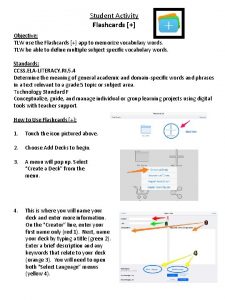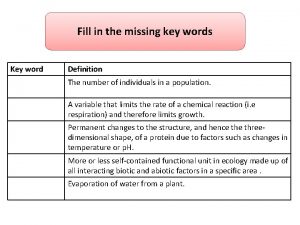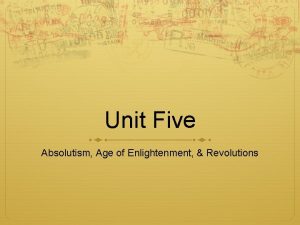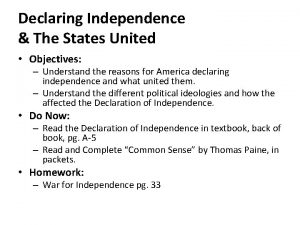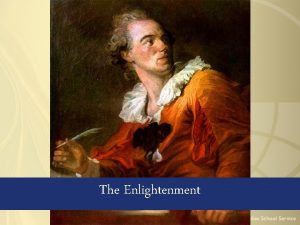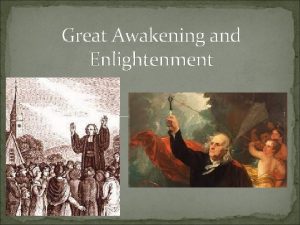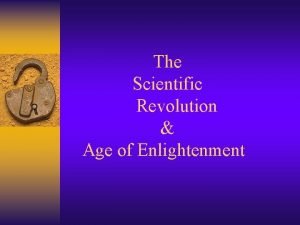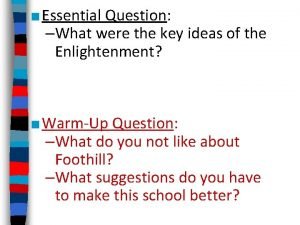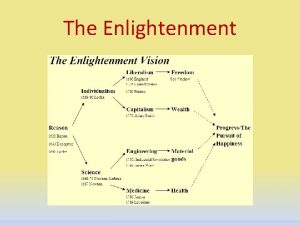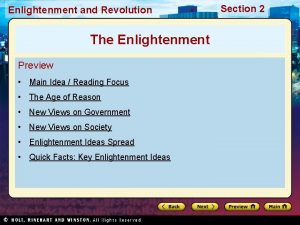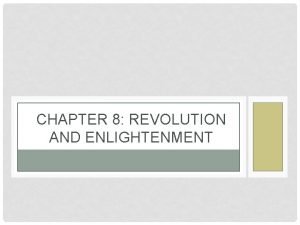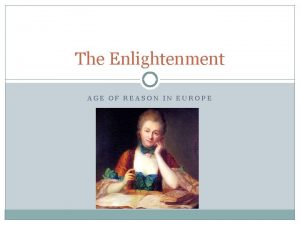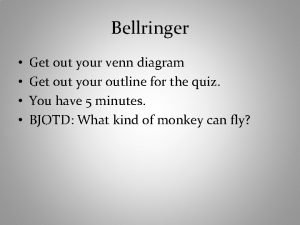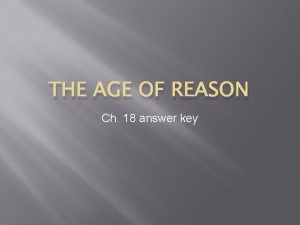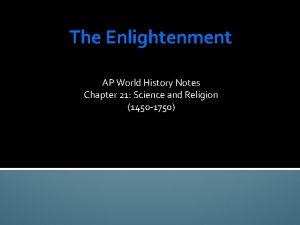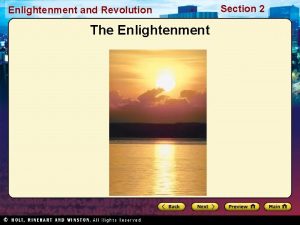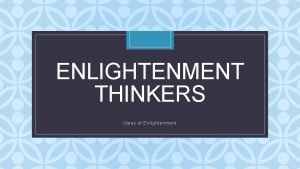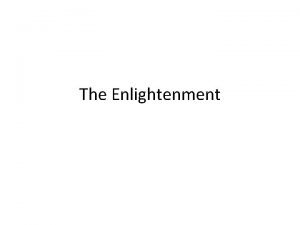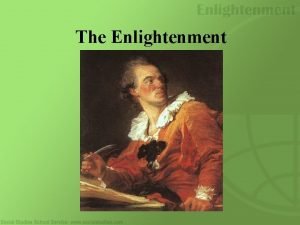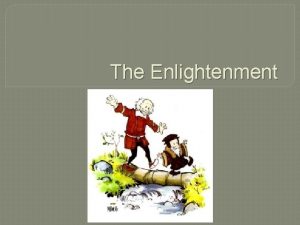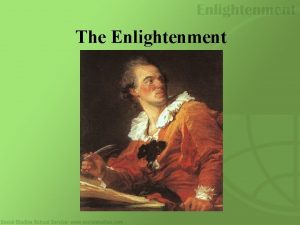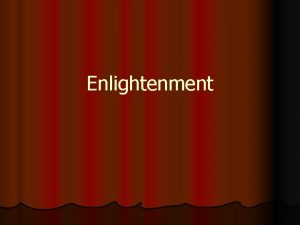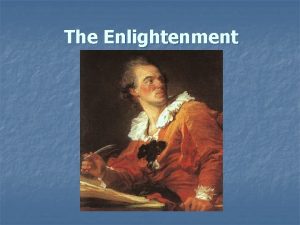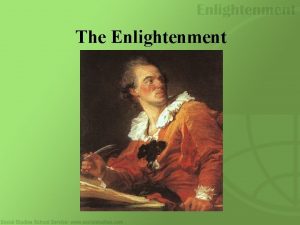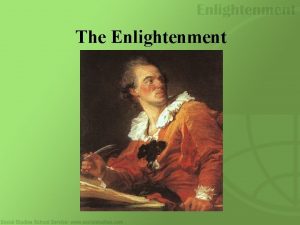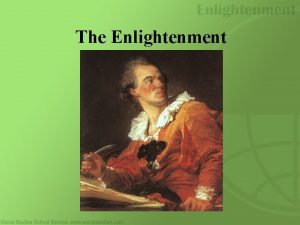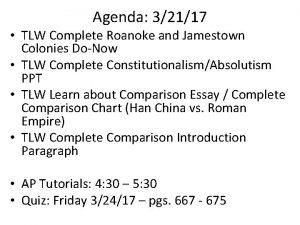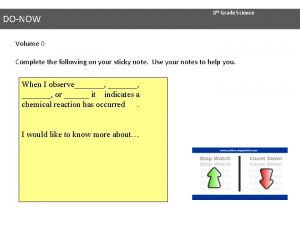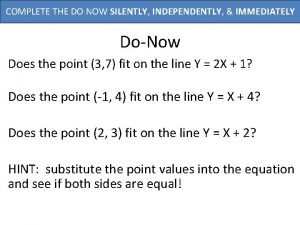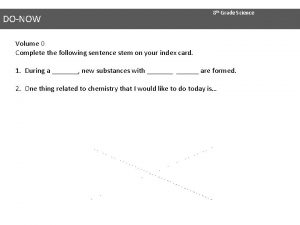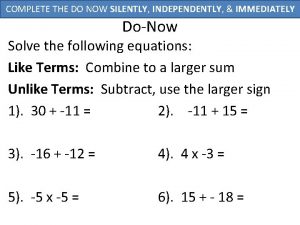Agenda 32717 TLW Complete Enlightenment DoNow TLW Complete
























- Slides: 24

Agenda: 3/27/17 • TLW Complete Enlightenment Do-Now • TLW Complete Start of the French Revolution PPT • TLW Complete Body Paragraph Overview/Body Paragraph 1 • TLW View Marie Antoinette (2016)

The French Revolution

The Old Order • During the Enlightenment, France was governed by Old Regime—Political system in France based on social classes –First Estate (Church)—Owned 10 percent land, lightly taxed – Second Estate (Nobles)—Owned 20 percent land, lightly taxed –Third Estate (Peasants) – 97% of population, Heavily taxed • Society had been divided into estates in France since the Middle Ages – several hundred years old • Power is kept in the First and Second Estates – Class of Nobles • Typically, the King is considered above all three estates


The Forces of Change • 1700 s France had financial problems –Debts from wars (American Revolution/Seven Yrs. War) –High taxes/high food prices – French money value decreased which made it difficult for common people to buy food – Third estate – Commoners – continued to be taxed while nobles and clergy continued to not pay taxes – Easiest way for people to be upset with their rulers – have weak economy with food shortage • The Enlightenment was also influential in starting a revolution in France –Educated members of the third estate – doctors, lawyers, etc. – knew/read writings by Locke, Rousseau about role of government and rights of citizens –Knew about Americans success in the American Revolution against British rule – made them think about what ways they could express their concerns

The Forces of Change (Cont. ) • King Louis XVI and his wife Marie Antoinette are the ruling monarchs at the time – Proved to be rather ineffective leaders –Louis XVI was Louis XIV’s grandson - Both were known for extravagance –Marie Antoinette in particular was into expensive fashion and hosted a lot of parties at Versailles –Dresses were known to cost hundreds to thousands; she was known as “Madame Deficit” –Every time news of a party or gathering hosted by Marie Antoinette made its way to the common people they got mad – why was Marie Antoinette spending money the French govt. didn’t have? • The Estates-General—A meeting of representatives from all three estates –is called to resolve problems in France

King Louis XVI and Marie Antoinette


Storming the Bastille • Rumors spread in Paris that Louis XVI was bringing in foreign troops to massacre the citizens – Supposed to have been a show a force so that the people wouldn’t rise up against the King and Queen of France – People looked for gunpowder and guns to protect themselves and the city (France) – Reality was that the rumors were mostly false – forces weren’t there to massacre the Parisians • July 14, 1789 – Parisian mob stormed the Bastille (prison) – seized the prison and killed many of the soldiers commanders that were stationed at the Bastille – placed their heads on pikes and carried them around the city – Symbolic act – Began French Revolution

Storming the Bastille

Rioting Continued • October 1789 – Thousands of Parisian women (fishers, bakers, etc. ) rioted over the rising price of bread – Nearly impossible to buy a single loaf – Assignats (dollar bills) had been circulated so much that they were almost worthless • Parisian women Used knives, axes, etc. and stormed the Palace of Versailles; even killed some of the guards – They demanded that King Louis XIV to bring down the price of bread and Demanded that the royal family leave the Palace of Versailles – Family is forced to head for a smaller residence in Paris, where the revolution festered anti-establishment sentiment grew more and more severe


Altogether! • Ex: Han China and Imperial Rome were two classical civilizations that brought unity and stability to the regions they existed in. Han China flourished in eastern portion of its modern borders in Asia while Imperial Rome thrived in the Mediterranean Basin. Both governments also had civil service systems in which hundreds of officials saw to different matters of government. Similarly, they also engaged in territorial expansion. However, they differed in how bureaucrats were picked for offices in government. They were also situated in different parts of the world; that being the case, Han China and the Roman

Step 3: Turn Similarities and Differences into Body Paragraphs • The similarities and differences listed in the introduction will be the body paragraphs. The order of the paragraphs depends on which of the similarities/differences was mentioned first. • • Paragraph 1: Civil Service System Paragraph 2: Territorial Expansion Paragraph 3: Colonies Paragraph 4: Religion

Step 3: Turn Similarities and Differences into Body Paragraphs • 1 Sentence: Write an intro sentence about the idea you are discussing between the two topics • Ex: Han China and Rome both had civil service systems that were expansive and helped run the government efficiently.

Step 3: Turn Similarities and Differences into Body Paragraphs • 2 – 3 Sentences: Write down the similarities between the two topics about the idea • Ex. The administrations of both governments required hundreds of officials and workers to manage the duties of the government. Also, officials were used to govern territories that were added to Han China and the Roman Empire

Step 3: Turn Similarities and Differences into Body Paragraphs • 2 -3 Sentences: Write down the differences between the two topics about the idea • However, the officials that participated in the Chinese government were scholar officials that had to pass rigorous exams while commoners and middle class people were elected/placed into government positions in Rome.

Altogether! • Take the topic sentence, the sentences about similarities, and the sentences about differences and put them together. • Han China and Rome both had civil service systems that were expansive and helped run the government efficiently. The administrations of both governments required hundreds of officials and workers to manage the duties of the government. Also, officials were used to govern territories that were added to Han China and the Roman Empire. However, the officials that

Altogether! Topic Sentence • Take the topic sentence, the sentences about similarities, and the sentences about differences and put them together. • Han China and Rome both had civil service Similaritie systems that were expansive and helped run s the government efficiently. The administrations of both governments Differences required hundreds of officials and workers to manage the duties of the government. Also, officials were used to govern territories that

Altogether! • Look at the topics you listed in your similarities (bureaucracy, territorial expansion, etc. ); number them – Paragraph 1: Civil Service System – Paragraph 2: Territorial Expansion – Paragraph 3: Colonies • Write topic sentence (1 -2 sentences) • Write the similarities (2 -3 sentences) • Write the differences (1 -2 sentences)


Marie Antoinette (2006) • Born to Austrian nobility, Marie Antoinette (Kirsten Dunst) is only 14 years old when she's pledged to marry Louis XVI (Jason Schwartzman), the 15 -yearold king of France, in an alliance that has everything to do with politics and nothing to do with love. Sent to France and literally stripped of her former life, Marie weds Louis, but to the consternation of the royal court, he seems either unwilling or unable to consummate the marriage while their advisors clamor for an heir to the throne. Young and more than a bit out of step with the new life that's been thrust upon her, Marie gives herself over to the pleasures of life in

• Marie Antoinette (2006) – Historical Background Marie A. (Maria Antonia) was born the youngest daughter of Maria Theresa, Empress of Austria – Bold, outgoing, sensitive and generous to the poor – supported the American Revolution – Had expensive schooling – poor student, couldn’t write German, Italian and French correctly by 10 – conversation was stilted • Betrothed to Louis XIV after her older sister died; she was 15 when she got married (was a child in most respects) – Empress Maria Theresa wanted to smooth relations between Austria and France, who had conflicts between them over territorial expansion • It took 8 years for Marie to get her husband to lay with her and produce an heir; Marie Therese (3 other

Major Characters • Marie Antoinette (Kirsten Dunst) – Young queen of France known for her elaborate lifestyle • King Louis XVI (Jason Schwartzmen) – Shy husband of Marie Antoinette, king of France • Countess of Noailles (Judy Davis) – Marie Antoinette’s tutor in etiquette in Versailles • Count of Mercy-Argenteau (Steven Coogan) – Adviser to Marie Antoinette; helped engineer her marriage • Louis XIV (Rip Torn) – Grandfather of Louis XVI; “Sun King” • Madame du Berry (Asia Argento) – Mistress of Louis XIV
 Tlw meaning school
Tlw meaning school Agenda sistemica y agenda institucional
Agenda sistemica y agenda institucional Complete the missing word to complete the three key words
Complete the missing word to complete the three key words Simple and complete subjects and predicates
Simple and complete subjects and predicates Enlightenment chart
Enlightenment chart John locke enlightenment
John locke enlightenment Enlightenment vs scientific revolution
Enlightenment vs scientific revolution The enlightenment influenced revolutionary thought by
The enlightenment influenced revolutionary thought by Enlightenment essential questions
Enlightenment essential questions Rene descartes enlightenment
Rene descartes enlightenment Enlightenment 17
Enlightenment 17 The enlightenment
The enlightenment Enlightenment ideas
Enlightenment ideas Scientific revolution and enlightenment speed dating
Scientific revolution and enlightenment speed dating What ideas is john locke known for
What ideas is john locke known for Francis bacon enlightenment ideas
Francis bacon enlightenment ideas Main idea of enlightenment
Main idea of enlightenment Hobbes
Hobbes Enlightenment principles
Enlightenment principles How were european rulers guided by enlightenment thought?
How were european rulers guided by enlightenment thought? John locke enlightenment
John locke enlightenment Scientific revolution and enlightenment speed dating
Scientific revolution and enlightenment speed dating The age of reason crossword puzzle answer key
The age of reason crossword puzzle answer key Chapter 21 lesson 2 the ideas of the enlightenment
Chapter 21 lesson 2 the ideas of the enlightenment Chapter 6 section 3
Chapter 6 section 3
